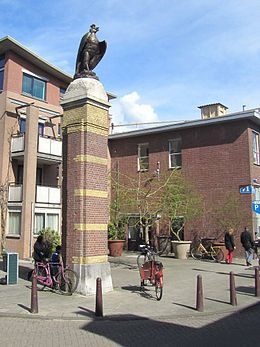

De Gekroonde Valk was the name of a legendary brewery located around this spot. The brewery and vinegar producer was founded by Jan van den Bosch in 18th century. A family from Rotterdam named Van Vollenhoven took over the business in 1791 and gave its last name to the several different types of beer produced, while the bottle labels showed a falcon with a crown on its head.
Around 1900, the brewery became the largest in the city and was led by Willem Hovy, who ran the company for decades. Under his leadership, the brewery grew to be among the three largest ones in the Netherlands. Hovy became known for liberal social management, which, for example, allowed sick workers a paid two-week leave. Employees who had just become fathers were temporarily given a double wage.
After World War II, the business took a downturn and, in 1949, Heineken took over the company. In 1956, the brewery went out of business altogether. To mark its 100th anniversary, in 1891, atop a 5,5 meter high pillar at former the entrance gate, cast-iron sculpture of a crowned falcon was erected. The falcon you see today is a replica of the original, while the latter belongs to the heirs of the company nowadays residing in South Africa.
Across the street, a row of 40 houses named De Sibbelwoningen and stationed along the former high embankment of the Hoogtekadijk were built in 1928 to house those who lived in the vicinity of the Rapenburgergracht canal (which is now called Entrepotdok ) as well as the workers of the abovementioned brewery. The houses were squatted in the 1970s and, thus, saved from demolition. The squatters movement played an important part in post-war Amsterdam, when many of its buildings stood empty and were decaying for decades. In the early 1980s the houses were renovated and, in the 1990s, designated as a national monument. In 2002, the homes were purchased by Woonstichting De Key (Residence Foundation De Key) for the symbolic amount of one euro and restored to their original state.
On April 28, 2011 the restored houses were completed. A plaque entitled Off the Dike, by the artist Hans 't Mannetje was unveiled on the eastern façade. The plaque refers to the times when the homes built atop dikes threatened to slide backwards, and marks the path where one can descend from the Hooghte Kadijk (literally, the high dike) to the Laagte Kadijk. (literally, the low dike).